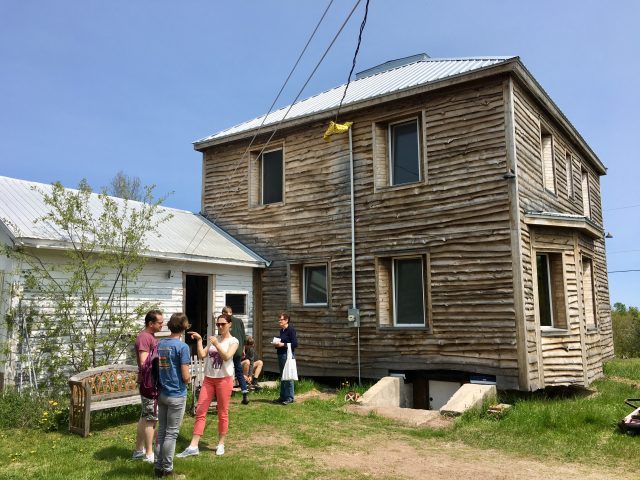The Conservation Council’s Jon MacNeill takes you along for his adventure during our Pathway to a Cleaner Future: EcoBuildings Tour, held in Greater Saint John, Fredericton and Moncton on Saturday, June 1.
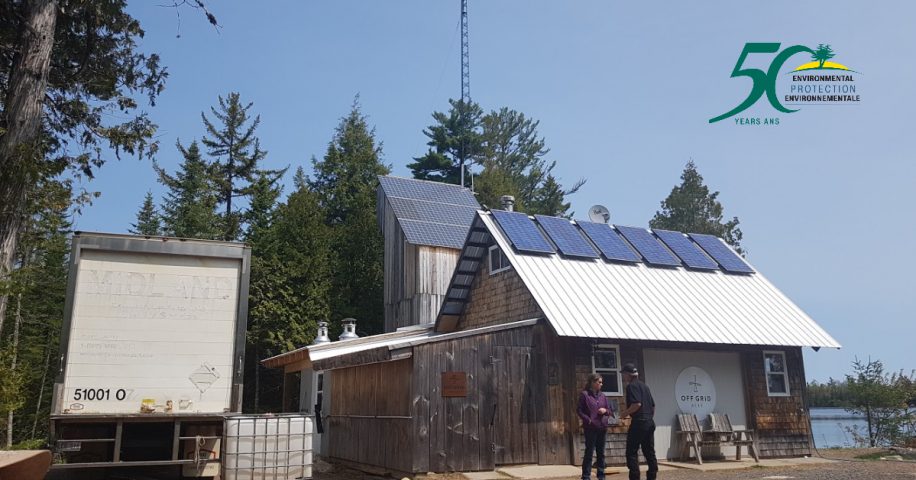
Josée Green didn’t want to save the world when she first started her journey toward energy efficiency and renewable energy. She didn’t even really care about saving money.
She just wanted to keep her kids safe and warm.
“It was December, we lost power for three days and I had to sleep under blankets with my son on my skin to keep him warm,” Green says from the kitchen of her super-energy-efficient home on Crockett Street in Fredericton, which sports a full array of solar panels on the roof.
“After that storm, we knew we needed almost like a doomsday plan. When the power goes out, you still need heat, you still need some kind of power. So we started to address those needs and that really woke us up to energy use and conservation.
“It arose out of a crisis, and then, just naturally, it turned into a hobby of wanting to do more, walk the walk, talk the talk, and really be part of the change.”
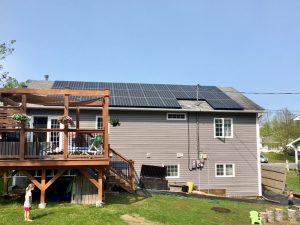
Green’s house was my last visit during the Conservation Council’s Pathway to a Cleaner Future: Eco Buildings Tour on June 1. Nearly two dozen homeowners and businesses opened their doors to a public eager to learn about people in their neighbourhood already making the shift to cleaner-energy living in the face of our changing climate.
After that storm seven years ago, Green started down a path that could serve as a model for a lot of us wondering what we can do to cut our home energy costs and our carbon pollution footprint.
She and her husband knew they wanted to install solar panels eventually, but that type of investment only made sense if they reduced their energy consumption as much as possible first.
They installed a heat pump and wood alternate heat with heat dump, the home’s primary source for keeping cozy. All LED lighting. Low-flow shower heads. Energy-efficient appliances. Super-insulated doors and windows.
“And then, eventually, we got to a point where our usage was down enough that solar made sense.”
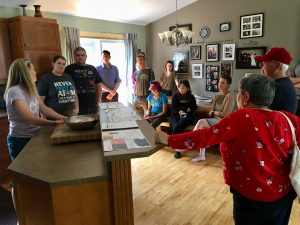
In 10 years — the time it takes to pay off the panels — her only power bill will be the $30 service charge and HST on the small amount they may end up drawing from NB Power.
The panels have a warranty for 25 years, translating to roughly 15 years of nearly free power.
“And by then, hopefully batteries will make more sense. So maybe Power Walls [made by Tesla] are part of what you can lease from NB Power. Maybe you can use the battery in your car to store your power. All that smart grid innovation piece, hopefully, in a few years, will make a lot more sense.”
‘This is my forever home’ — a model for N.B.’s old housing stock
Josée Green’s modern, energy-efficient-to-the-nines home is where I ended my day on the tour. But I started 70 kilometres downriver in Gagetown, at a home like many in New Brunswick, decades-upon-decades old.
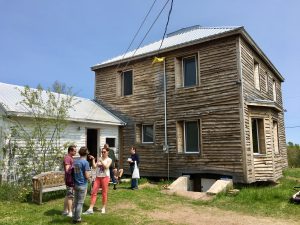
“It just blew our minds. We only spent $200 for heat,” Edee says, with a tone that lets you know she’s still trying to wrap her head around it. But the answer to how it was possible, of course, is what’s wrapped around the century-old home.
Garth and Edee wanted to maintain the character and charm of the 20th century homestead, so instead of tearing up the inside walls and mouldings to retrofit for energy efficiency, they built out.
Sixteen inches of insulation were added to the exterior of the home, giving them R50 walls. The home is primarily heated with a geothermal preheat/precool system, so they only need one baseboard heater on the first floor to get the entire house through the coldest snaps of winter.
“I know,” Edee says, when my jaw drops at this information. “It’s insane.”
The home’s super-efficient doors and windows retain the sun’s heat. Two layers of a special membrane act as ‘lungs’ so moisture and condensation aren’t an issue in such an airtight envelope.
The retrofit resulted in a 90 to 95 per cent reduction in energy usage — and some pretty solid perks for what was once an old, drafty home.
“The fact I can walk around in barefeet in the middle of winter, I’m thrilled. And I tell you, it’s magnificent to be sleeping and it can be minus 30 outside, you’re lying in bed, you can smell the fresh air coming in, but the air isn’t cold,” Edee says.
“It’s just the comfort of it all.”
And not to mention, the savings. Garth, who lives and breathes Passive Home design, has set sensors all over the house to monitor humidity and has designated electrical outlets as either for heating units or general-use applications, like lamps. They can track their usage down to a science and constantly calibrate, adapt and improve when possible.
He calculates in 10 years they’ll have saved $18,000 in energy and heating costs. In 25 years, the couple will have saved $105,000.
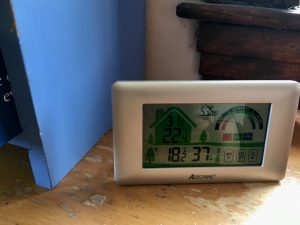
As I make my way downstairs to carry on with the Eco Buildings Tour — a bit dizzy with thoughts of all I could do with a cool $100,000 (goodbye student loans, hello med school for my surgeon-obsessed daughter) — I meet Tim and Angela Sanford. They’ve just arrived and, as it happens, are planning to build their retirement home using a Passive House design.
They’re the first of several people — from close-to-retirees to young families looking to build their first home — who tell me they’re on the tour because they have concrete plans to build a Passive Home in the next year or two.
“I’m cheap,” Tim says bluntly, with a chuckle. “We’re both engineers. I like low-operating costs. Part of what I do every day at work is figuring out how to do things cheaper.”
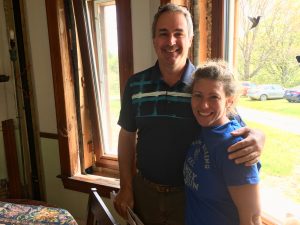
“And energy efficiency is important to us, as well,” Angela says. “It’s nice reducing your carbon footprint and being more globally-conscious in building. And something like this home, it just shows that it can be done, even in our climate, that if you set yourself up properly, you can enjoy the benefits.”
‘Every home needs a sunroom’
One step inside Dorothy and Tony Diamond’s Passive Solar Home outside Stanley, and you can tell the couple is really excited for curious minds to visit.
Their spacious, naturally-lit, one-storey home is filled with notes encouraging participants to try different ways of doing common household tasks and save money — all while reducing their carbon footprint.
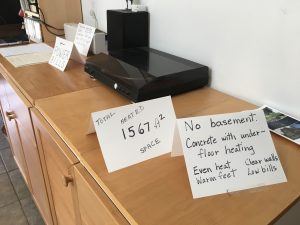
The Diamonds’ home is decked out with similar energy-efficiency features as Garth, Edee and Josée’s homes, with one significant difference.
The whole place is heated by a geothermal in-floor radiant heating system, installed in 2005 and likely one of the first of its kind in the province.
Well water, the same they use for drinking, is pumped in through the heat pump, stored in a hot-water tank and run through pex pipe encased in a layer of concrete under their floors.
Asked what the system means in practical terms, Dorothy gives me an answer much the same as Edee: “It’s lovely. You can go barefoot in the winter. It’s really, really lovely.
“You don’t have any baseboards. You don’t have radiators. You don’t have air blowing around with dust in it. There are so many reasons, it’s worth every penny. It’s a more expensive heating system, but we’ve had no maintenance issues in 15 years,” Dorothy says.
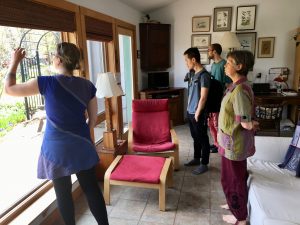
Her favourite place is the home’s super-insulated sunroom, which also helps heat the rest of the home in the winter.
“It’s lovely in the summer, but it’s even better in the spring, fall and winter. You can sit here and read. The sun just pours in. Plus, it helps psychologically. In our really long winters, it’s nice to have a sunroom where you can sort of pretend you’re outside. Just put on a bathing suit and sit out there,” she says with a chuckle.
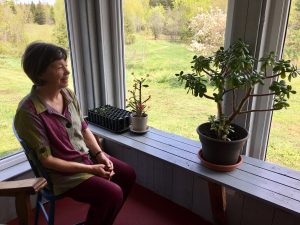
Outside in the Diamonds’ backyard, where the couple raise chickens and hens, keep bees, tap maple trees and grow a gorgeous garden, I meet Lee McLean.
Her husband Tom has been in the media lately, advocating for the widespread adoption of electric vehicles in New Brunswick. The McLeans own two EVs and Lee quips that she calls her husband “the poster boy for electric cars in N.B.”
They’re on the tour because they’ve outgrown their current home and are looking for ideas. They’re not sure, though, exactly what they’ll do yet.
“Some people buy a retirement property, we bought electric vehicles,” she said, adding they took advantage of the federal government’s new rebate incentive for their second EV. “It’s a different approach, but we’re going to travel that way, instead of flying, so we have a smaller footprint.”
‘I’m excited to see what I can grow’
Down the road a ways in Durham Bridge, I pull into Andrew and Anna Mathis’ home, which much like every other stop so far, is a happening spot. Eleven cars line the drive.
Andrew has designed a greenhouse powered by a ‘climate battery’ to heat and cool the space, allowing produce to grow year-round. He designed the greenhouse at The Ville in Fredericton, which last winter produced tomatoes in February, and is focusing his PhD research on this type of system.
The greenhouse is a work-in-progress but next year he hopes to introduce an aquaponics system into the mix. It would allow fish raised in tanks half in the ground, half in the greenhouse to produce waste that feeds nutrients to his plants. He can then eat the fish to get some extra protein out of the greenhouse.
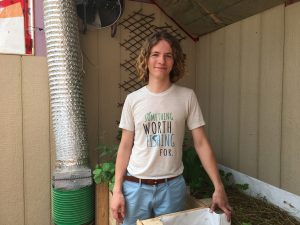
“It’s a copy of a natural system in nature and doing this reduces the water usage of growing plants by 90 per cent,” Andrew tells a crowd of us gathered in the space, which has special-glazed windows facing the winter solstice sun to maximize its passive solar heating potential in colder months.
This will be his first winter growing crops year-round.
“The climate battery design is all about the storing of heat through cold periods. It’s the regulation of the temperature, instead of having really high extremes and really low minimums, it kind of evens everything out as much as possible.”
Comfort, savings, peace of mind — all within reach
I met Derek and Marilyne LaCombe with their three-month-old Antoine, at our post-tour gathering at The Ville. The couple took the tour because they plan to build a Passive Solar Home within two years. And because seeing is believing.
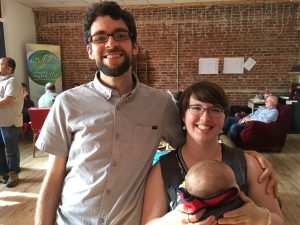
“We can read and amass our knowledge, but there’s nothing like being able to see it, touch it, feel it,” Derek says. “To see exactly how triple-glazed windows work. I mean, you read about it, but there’s nothing like actually seeing the thickness of it in person.”
Pauline and Ken Methot, who live on Crockett Street in Fredericton, just down the way from Josée Green’s place, are also at the meet-up. They’re enjoying some cucumber sandwiches, hummus and pita, all kinds of good healthy stuff.
I’d met them about an hour earlier leaving the Mathis’ greenhouse, where Ken told me how neat it was seeing the sustainable living concepts he read about as a kid in his father’s copies of Harrowsmith Magazine finally taking root in New Brunswick.
“It was all well and good to read about it as a kid, but it’s another thing to be out on this tour and actually seeing it put into practice,” the licensed carpenter says. “That’s the hope for our society.”
“It was interesting to see that somebody on our own street was really embracing this technology,” Pauline adds. “Because you know, people think that it’s really expensive and not worth it to do this kind of stuff in their homes. Before today, I was one of those people. Not anymore. Now I’m making plans.”

